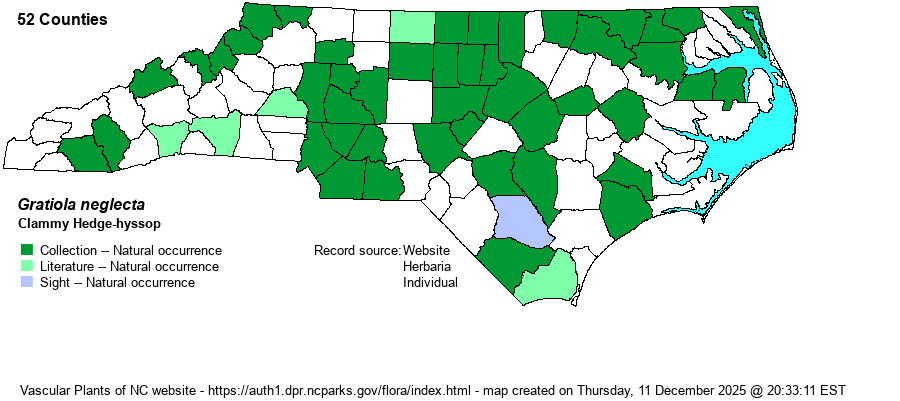| Author | Torrey | |
| Distribution | Scattered across the state, but more frequent in the central and eastern Piedmont and most of the Coastal Plain. Likely overlooked in some other counties.
This is a very widespread species across the country, ranging south to central GA, with only FL lacking records. | |
| Abundance | Infrequent to fairly common from the central Piedmont eastward to most of the Coastal Plain, but uncommon toward the coast. Uncommon to infrequent in the Mountains and western Piedmont. The NCNHP's S3 State Rank is certainly too conservative, as the species has been collected statewide and from around 45 counties, plus a good handful of iNaturalist photos from other counties. The website editors suggest a rank of S4. | |
| Habitat | This species grows in mud or very shallow water in many places. It cam be found in ditches, shallow pools, swampy openings and edges, wet bottomlands, and rarely in wet fields. These are essentially the same habitats where the similar G. virginiana grows. | |
| Phenology | Blooms mainly in April and May, rarely later; fruits from May to July. | |
| Identification | This is a slender and small, unbranched herb (though several stems can occur from a single base), growing only to about 6-8 inches high. In this species, the stem is not succulent or wide, as opposed to that feature in G. virginiana. It has a few pairs of opposite leaves, each of which is sessile but generally elliptic and entire, to about 1.5 inches long and 1/4-inch wide. One or two flowers grow from each leaf axil, but these are on long and extremely slender pedicels, about 2/3-inch long; the small flowers are white and mostly tubular, being about 1/3-inch long. The similar G. virginiana has the flowers almost sessile from an axil. These and most other Gratiola species are so small that to see them well you need to practically get down on hands and knees, so you may need to see them through binoculars or a camera lens. But, none are really hard to identify from another, as long as you observe them closely. This is the one with slender leaves tapering to the stem, a slender stem, and very long and slender flower stalks. | |
| Taxonomic Comments | None
| |
| Other Common Name(s) | None | |
| State Rank | S3 [S4] | |
| Global Rank | G5 | |
| State Status | | |
| US Status | | |
| USACE-agcp | OBL link |
| USACE-emp | OBL link |

